Sweet Gleam |
||||||||||
 |
 |
|||||||||
Knitted sweater for baby in DROPS Sky. The piece is worked top down, with round yoke and ribbing on the yoke. Sizes: Premature to 2 years.
DROPS Baby 43-5 |
||||||||||
|
------------------------------------------------------- EXPLANATIONS FOR THE PATTERN: ------------------------------------------------------- RIDGE/GARTER STITCH (worked in the round): 1 ridge in height = 2 rounds; Knit 1 round and purl 1 round. RIDGE/GARTER STITCH (worked back and forth): Knit all rows. 1 ridge = knit 2 rows. PATTERN: See diagrams A.1 to A.5. The diagrams show all rows in the pattern from the right side. DECREASE TIP (for sleeves): Start 3 stitches left before the marker, knit 2 together, knit 2 (marker sits between these 2 stitches), slip 1 stitch as if to knit, knit 1 and pass the slipped stitch over the knitted stitch. BUTTONHOLES: (if you work a split mid-back). Work the buttonholes at the beginning of the row from the right side as follows: Knit 2 make 1 yarn over and knit the next 2 stitches together. On the next row (wrong side) knit the yarn over to leave a hole. The first buttonhole is worked when the neck measures 1½ cm = ½", the other 2 buttonholes are worked with (2½) 2½-3-3-4 (4) cm = (1") 1"-1⅛"-1⅛"-1½" (1½") between each one. ------------------------------------------------------- START THE PIECE HERE: ------------------------------------------------------- SWEATER – SHORT OVERVIEW OF THE PIECE: The neck and yoke are worked in the round with circular needle, from mid back and top down. If you work a split mid-back, you start the piece working back and forth before it is joined and continued in the round. The yoke is divided for body and sleeves and the body is continued in the round with circular needle. The sleeves are worked with double pointed needles. SWEATER WITHOUT SPLIT MID-BACK: Cast on (52) 56-60-64-68 (72) stitches with short circular needle size 3 MM = US 2.5 and DROPS Sky. Knit 1 round. Then work rib (knit 1, purl 1) for (2) 2-3-3-4 (4) cm = (3/4") ¾"-1⅛"-1⅛"-1½" (1½"). On the next round increase every other purl-1 to purl-2 by making 1 yarn over (on the next round purl the yarn overs twisted to avoid holes) = (13) 14-15-16-17 (18) increased stitches and (65) 70-75-80-85 (90) stitches. Continue the new rib until the neck measures (3) 3-4-4-5 (5) cm = (1⅛") 1⅛"-1½"-1½"-2" (2"). Insert 1 marker at the beginning of the round; the yoke is measured from this marker. Change to circular needle size 4 MM = US 6. Work 1 RIDGE over all stitches – read description above. AT THE SAME TIME on the first round adjust the number of stitches to (64) 68-76-80-84 (88) stitches. After the ridge work the next round as follows: * A.1, A.2 *, work from *-* to the end of the round = (96) 102-114-120-126 (132) stitches. Complete A.1 and A.2, then continue with knit 3 / purl 3 until the yoke measures (4) 5-5-5-6 (6) cm = (1½") 2"-2"-2"-2⅜" (2⅜") from the marker on the neck. Work the next round as follows: SIZE (<0): * A.3, A.4 *, work from *-* to the end of the round. SIZES 0/1 – 1/3 – 6/9 – 12/18 months (2 years): * A.3, A.5 *, work from *-* to the end of the round. After the first round, there are (128) 153-171-180-189 (198) stitches. Complete A.3 and A.4/A.5, then continue with knit 5 / purl 3 in size (<0) and knit 5 / purl 4 in the other sizes and until the yoke measures (8) 10-10-10-12 (12) cm = (3⅛") 4"-4"-4"-4¾" (4¾") from the marker. Continue from SWEATER below. SWEATER WITH SPLIT MID-BACK: Cast on (57) 61-65-69-73 (77) stitches with short circular needle size 3 MM = US 2.5 and DROPS Sky. Purl 1 row from the wrong side. Then work the next row as follows (from mid-back): 4 stitches in GARTER STITCH – read description above, * knit 1, purl 1 *, work from *-* until there are 5 stitches left, knit 1 and 4 stitches in garter stitch. Continue this rib for (2) 2-3-3-4 (4) cm = (3/4") ¾"-1⅛"-1⅛"-1½" (1½") – remember the BUTTONHOLES on the band – read description above. On the next row from the right side increase every other purl-1 to purl 2 by making 1 yarn over (on the next row knit the yarn overs twisted to avoid holes) = (12) 13-14-15-16 (17) stitches increased and (69) 74-79-84-89 (94) stitches. Continue the new rib until the neck measures (3) 3-4-4-5 (5) cm = (1⅛") 1⅛"-1½"-1½"-2" (2"). Insert 1 marker after the band; the yoke is measured from this marker! Change to circular needle size 4 MM = US 6. Work 1 ridge over all stitches – AT THE SAME TIME on the first row increase (1) 0-3-2-1 (0) stitches evenly spaced = (70) 74-82-86-90 (94) stitches. After the ridge, work the next row as follows from the right side: 4 stitches in garter stitch, * A.1, A.2 *, work from *-* until there are 6 stitches left, A.1 and 4 stitches in garter stitch = (101) 107-119-125-131 (137) stitches. Complete A.1 and A.2, then continue with knit 3 /purl 3 until the yoke measures (4) 5-5-5-6 (6) cm = (1½") 2"-2"-2"-2⅜" (2⅜") from the marker on the neck. Now join the piece as follows: Lay the button-band at the beginning of the row on top of the 4 last stitches, so that the band with the buttonholes are on the top. Knit the stitches from both bands together 2 and 2 (= 4 stitches decreased) = (97) 103-115-121-127 (133) stitches. Then continue the rest of the round as follows (after the 4 band stitches): SIZE (<0): * A.3, A.4 *, work from *-* until there are 3 stitches left before the band, work A.3, purl 2 (the first 2 stitches on band). SIZES 0/1 – 1/3 – 6/9 – 12/18 months (2 years): * A.3, A.5 *, work from *-* until there are 3 stitches left before the band, work A.3, purl 2 (the first 2 stitches on band). The round now begins in the middle of the 4 band stitches and after the first round, there are (129) 153-171-180-189 (198) stitches. Complete A.3 and A.4/A.5 (the 4 band stitches are now worked as shown in A.4), then continue with knit 5 / purl 3 over the other stitches in size (<0) and knit 5 / purl 4 in the other sizes and until the yoke measures (8) 10-10-10-12 (12) cm = (3⅛") 4"-4"-4"-4¾" (4¾") from the marker. Continue from SWEATER below. SWEATER: Knit 1 round and adjust the number of stitches to (132) 152-164-180-184 (200) stitches. Purl 1 round. Continue with stockinette stitch until the yoke measures (10) 11-12-12-13 (14) cm = (4") 4⅜"-4¾"-4¾"-5⅛" (5½") from the marker. On the next round divide for the body and sleeves as follows from mid-back: Work the first (18) 21-23-25-26 (29) stitches, place the next (30) 34-36-40-40 (42) stitches on a thread for the sleeve, cast on (4) 4-6-6-8 (8) stitches (in side under sleeve), work (36) 42-46-50-52 (58) stitches, place the next (30) 34-36-40-40 (42) stitches on a thread for the sleeve, cast on (4) 4-6-6-8 (8) stitches (in side under sleeve), work the last (18) 21-23-25-26 (29) stitches. The body and sleeves are finished separately. The piece is now measured from here! BODY: = (80) 92-104-112-120 (132) stitches. Continue with stockinette stitch in the round for a further (6) 9-12-12-15 (16) cm = (2⅜") 3½"-4¾"-4¾"-6" (6¼"). Knit 1 round where you increase (12) 14-16-16-18 (20) stitches evenly spaced = (92) 106-120-128-138 (152) stitches. Change to circular needle size 3 MM = US 2.5. Work rib (knit 1, purl 1) for (2) 2-2-3-3 (3) cm = (3/4") ¾"-¾"-1⅛"-1⅛" (1⅛"). Bind off a little loosely. The sweater measures approx. (20) 24-28-30-34 (36) cm = (8") 9½"-11"-11¾"-13⅜" (14¼") from the shoulder down SLEEVES: Place the (30) 34-36-40-40 (42) stitches from the thread on the one side of the piece on double pointed needles size 4 MM = US 6 and knit up 1 stitch in each of the (4) 4-6-6-8 (8) stitches cast on under the sleeve = (34) 38-42-46-48 (50) stitches. Insert a marker in the middle of the (4) 4-6-6-8 (8) stitches under the sleeve. Start at the marker and work stockinette stitch in the round for 1 cm = ⅜". Now decrease 2 stitches under the sleeve (does not apply to sizes <0 and 0/1 month) – read DECREASE TIP. Decrease like this every 4th round a total of (0) 0-1-1-1 (2) times = (34) 38-40-44-46 (46) stitches. Continue working until the sleeve measures (5) 8-10-13-15 (19) cm = (2") 3⅛"-4"-5⅛"-6" (7½") from the division. There is approx. (2) 2-2-3-3 (3) cm = (3/4") ¾"-¾"-1⅛"-1⅛" (1⅛") to finished length; try the sweater on and work to desired length. Knit 1 round where you decrease (0) 0-0-4-4 (2) stitches evenly spaced = (34) 38-40-40-42 (44) stitches. Change to double pointed needles size 3 MM = US 2.5 and work rib (knit 1, purl 1) for (2) 2-2-3-3 (3) cm = (3/4") ¾"-¾"-1⅛"-1⅛" (1⅛"). Bind off a little loosely The sleeve measures approx. (7) 10-12-16-18 (22) cm = (2¾") 4"-4¾"-6¼"-7" (8¾") from the division. Work the other sleeve in the same way. ASSEMBLY: If you have worked a split mid-back, sew the buttons onto the band without the buttonholes. |
||||||||||
Diagram explanations |
||||||||||
|
||||||||||

|
||||||||||
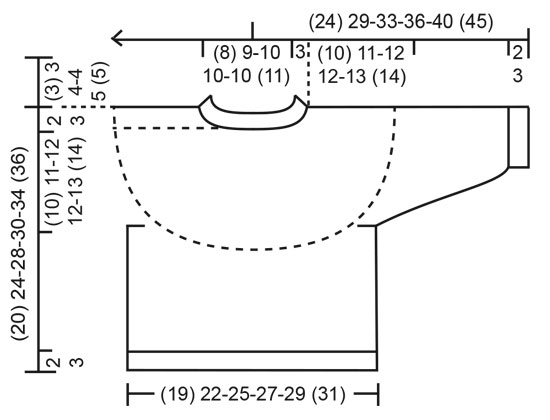
|
||||||||||
|
Have you made this or any other of our designs? Tag your pictures in social media with #dropsdesign so we can see them! Do you need help with this pattern?You'll find tutorial videos, a Comments/Questions area and more by visiting the pattern on garnstudio.com. © 1982-2024 DROPS Design A/S. We reserve all rights. This document, including all its sub-sections, has copyrights. Read more about what you can do with our patterns at the bottom of each pattern on our site. |
||||||||||







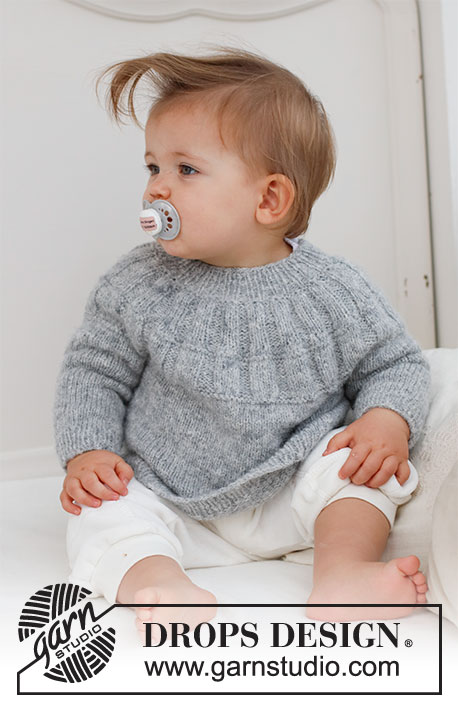
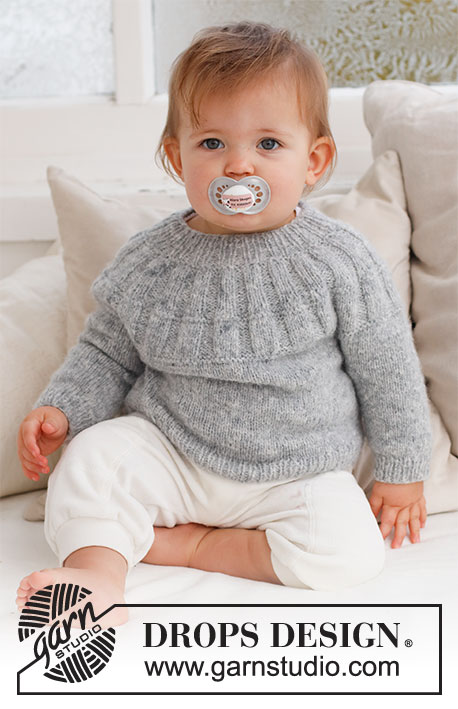
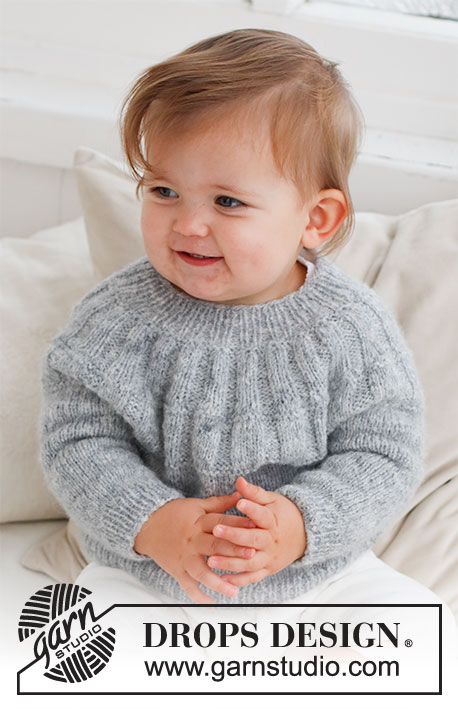


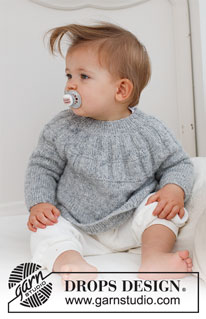
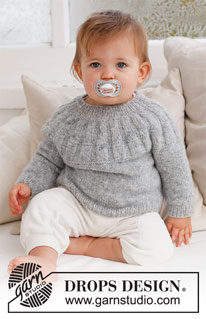
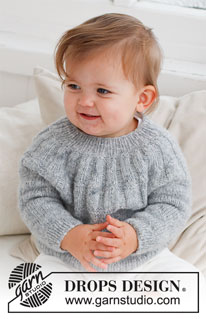






















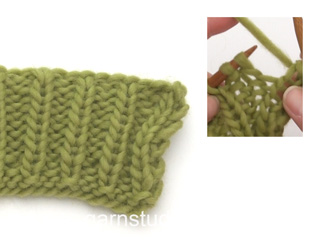


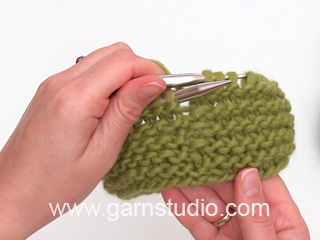



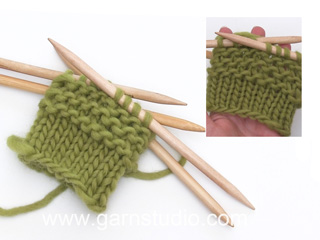


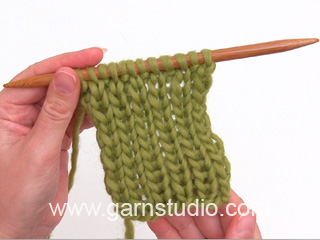





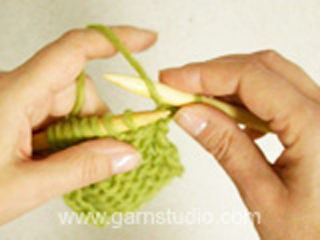























Comments / Questions (33)
Por favor me podríais explicar bien como se une la cenefa para continuar tejiendo en circular gracias
19.11.2022 - 01:48DROPS Design answered:
Hola Loly, para unir la labor: colocar los 4 puntos de la cenefa con los ojales sobre los 4 puntos de la cenefa con los botones. Se trabajan juntos el 1º punto de la cenefa de los ojales con el 4º punto de la cenefa de los botones; el 2º de los ojales con el 3º de los botones; el 3º de los ojales con el 2º de los botones y el 4º de los ojales con el 1º de los botones.
20.11.2022 - 23:20Hola cuando decís, en el jersey con abertura 4 puntos en punto musgo 1 derecho 1 revés trabajar de *a* hasta que queden5 puntos 1 derecho y 4 puntos en punto elástico quisiera saber si es equivocación y hay que tejerlos en punto musgo como al comenzar gracias
17.11.2022 - 13:35DROPS Design answered:
Hola Loly, sí, se trata de punto musgo, es una errata. Lo corregiremos lo antes posible.
20.11.2022 - 23:15Når man strikke etter diagrammet, skal man begynne oppe eller nede på A1 og A2? Om man skal begynne med å kunn strikke 3 rett og 3 vrang eller at man skal begynne med å strikke 1 rett øke 1, 2 rett, 1 vrang øke 1 så strikke to vrang?
12.11.2022 - 20:39DROPS Design answered:
Hei Anja, Diagrammene er lest fra bunnen oppover og fra høyre til venstre, Så da er det 1 rett, 1 kast, 1 rett på både A.1 og A.2, og dette er gjentatt på omgangen. God fornøyelse!
14.11.2022 - 06:57Tampoco entiendo cuando decís los 4 puntos de las cenefas ahora se trabajan como se muestra en A4 si en A4 solo hay 3 puntos
09.11.2022 - 17:16DROPS Design answered:
Hola Loly, lo que quiere decir es que los puntos de las cenefa se trabajan como el resto de los puntos, siguiendo el patrón A.4 (serían todos de derecho o todos de revés, dependiendo de la fila que estés trabajando).
14.11.2022 - 00:18El el jerseycon abertura en el centro de la espalda, a que os referís cuando decís al principio de comenzar la labor trabajar1 fila de reves por el lado reves de derecho gracias
09.11.2022 - 14:30DROPS Design answered:
Hola Loly, se trata de una errata, trabajas 1 fila de revés por el lado revés.
14.11.2022 - 00:15Hvor finder man diagram A1 - A5 i opskriften? ?
25.09.2022 - 18:41DROPS Design answered:
Hei Hanne. De finner du rett over målskissen helt nederst på oppskriften. Om du ikke ser de, er det mulig nettet ditt ikke greier å laste det ned. Sjekk da med et hurtigere nett. mvh DROPS Design
26.09.2022 - 11:54I’m knitting this jumper and I’m a bit confused - I’ve just completed the yoke but have far more stitches than the pattern suggests I ought to have. I have 207 stitches and I’m knitting size 1-3m. The pattern says to “adjust to 164 stitches”, which seems a considerable decrease. Is this correct? Thank you!
19.09.2022 - 23:37DROPS Design answered:
Dear Catherine, it looks like you have too many stitches in this size, you should have only 171 sts before starting the section and the round adjusting to 164 - where you are just supposed to decrease 7 sts evenly on the round (see here). Happy knitting!
20.09.2022 - 09:57🤣Und bei mir auch, nicht Feuerteufel, natürlich Fehlerteufel
27.08.2022 - 13:48Das erstmal vorweg, eure Anleitungen und Garne sind super, stricke gerade den Sweet Gleam Pulli mit Schlitz in Größe 80/86, und da hat sich, glaube ich, ein Feuerteufel eingeschlichen, bei der Zusammenführung der Knopfleiste werden 4 Maschen zusammen gestrickt, ich hatte vorher 131 - 4=127 und nicht 137 Liebe Grüße
27.08.2022 - 13:45Buenos días: En el patrón 43/5, jersey con abertura en la espalda, no entiendo cómo unir los 4 puntos musgo de la cenefa, con los otros 4 puntos musgo de la otra cenefa, para continuar tejiendo en redondo. Tienen un video? o mejor explicación ? Mil gracias. Ana.
21.08.2022 - 18:22DROPS Design answered:
Hola Ana, colocamos los 4 puntos de la cenefa con ojales sobre la cenefa donde vamos a coser los botones. Ahora, trabajar juntos el primer punto de una cenefa con el 4º pt de la otra, el 2º pt con el 3º de la otra cenefa, el 3º pt con el 2º de la otra cenefa y el 4º punto con el 1º de la otra cenefa.
21.08.2022 - 20:29